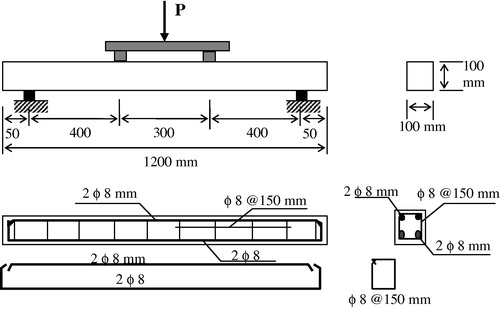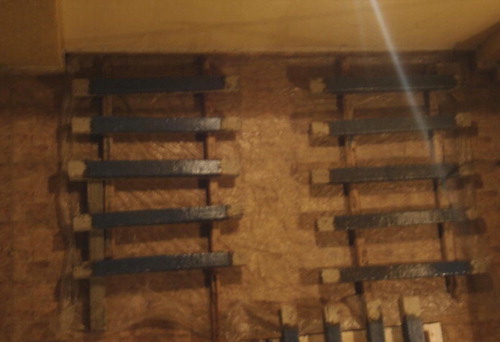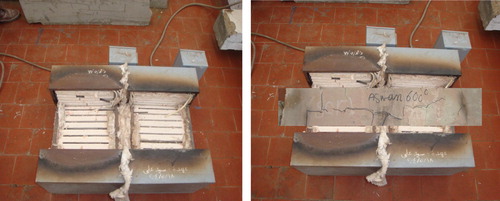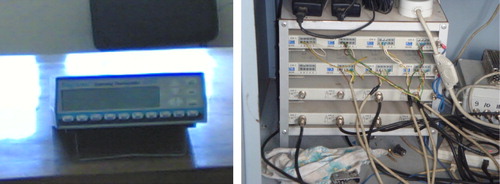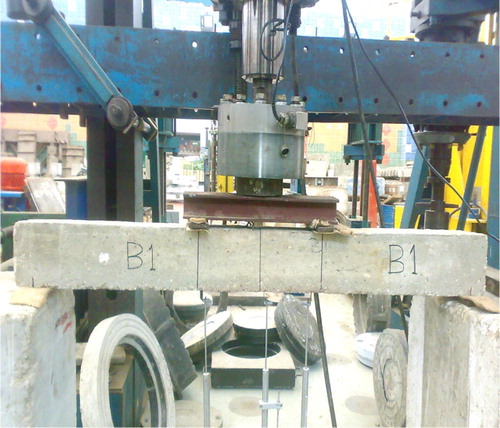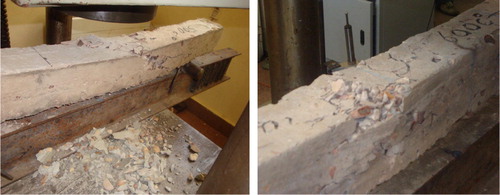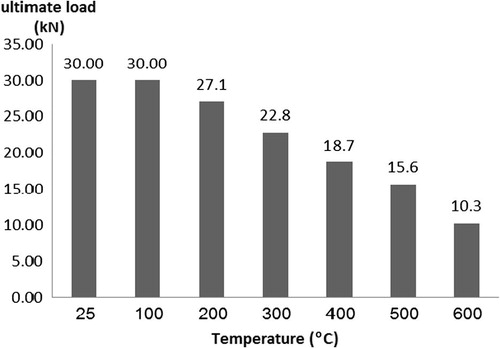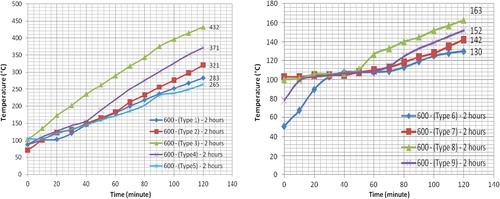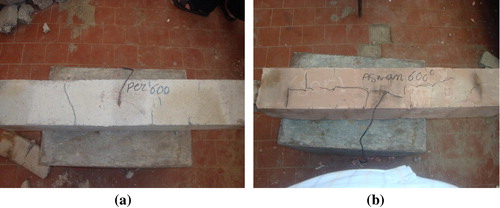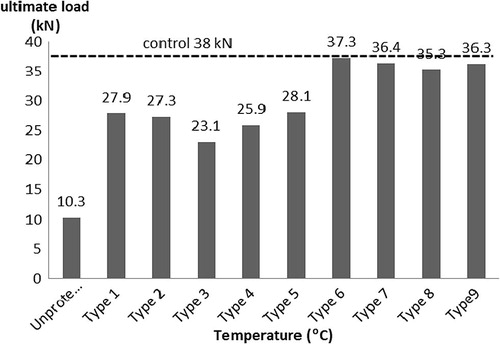Abstract
This paper investigates the efficiency of coating layers used for thermal protection of Fiber-Reinforced Polymer (FRP) strengthened Reinforced Concrete (RC) beams.
An experimental program was carried out on 36 RC beams protected by using different coating layers of Perlite, Vermiculite, Portland Cement (PC) mortar, clay and ceramic fiber. The tested beams were exposed to 100, 200, 300, 400, 500, and 600 °C for 2 h, left to cool gradually, then tested to failure. The obtained results demonstrated that exposure to elevated temperature without protection reduces the residual flexural strength of RC beams by 20–66%, depending on the degree of temperature. Protecting RC beams by a 30 mm-thick layer of the tested materials was demonstrated to be efficient in reducing heat transfer through 2-h exposure to 600 °C, and thus provide higher fire rating. Protection layers of cement mortar, Aswan clay, Vermiculite, Perlite and ceramic fiber blanket, showed residual flexural capacity equal to 61%, 68%, 72%, 73% and 74% that of the control beam, respectively. Moreover, using double coating layers of ceramic fiber followed by Perlite plaster, Vermiculite plaster, PC plaster or Aswan clay, with overall total thickness of 50 mm was demonstrated to give better protection, and maintain residual flexural capacity only 5% less than the flexural capacity of control beams.
Introduction
In the recent years, there was a strong need to repair/strengthen concrete structures due to material deterioration, environmental effects, misuse or overloading. As an alternative to traditional strengthening techniques, Fiber-Reinforced Polymers (FRP) are being increasingly used due to their desirable attributes. Although FRP strengthening proved efficiency in practice, there are increasing concerns related to their performance in case of fire. Polymer materials exhibit a change in mechanical properties when exposed to temperature higher than 80–120 °C, referred to as the glass transition temperature (Tg). This causes serious damage to the bond between the FRP and the concrete surface and consequently the structural integrity and effectiveness of the FRP strengthening will be severely threatened or may be totally lost.
Some design codes such as ACI 440-2008 [Citation1] do not recommend the use of FRP internal or external reinforcements for structures in which fire resistance is essential. Other codes limit strengthening by externally bonded FRP to only 40% of the capacity, for the unstrengthened concrete element to be sufficient to resist the service loads [Citation2].
Elevated temperature conditions occurring in case of fire have damaging effects on concrete structures [Citation3]. Temperature rise between 100 and 200 °C causes the free moisture contained in the concrete mass to evaporate and thus the high internal steam pressure generated may cause spalling of concrete [Citation3]. The reduction in concrete compressive strength may reach 15–40% and 55–70% of its original value for concrete when exposed to elevated temperature of 300 and 600 °C, respectively [Citation4,Citation5]. Concrete samples subjected to 600 °C for 2 h in a closed furnace, cooled slowly in air and then tested to failure gave compressive, tensile and flexural strengths of 56%, 31% and 18% of the control specimen, respectively [Citation6].
Previous researches investigated the effect of elevated temperature (fire) on FRP-strengthened RC elements [Citation6–Citation[7]Citation[8]Citation[9]Citation[10]Citation[11]Citation12]. For strengthened RC beams with externally FRP laminates, a sufficiently high shearing force must be developed and transferred by the interface layers between concrete and FRP laminates. This shearing force is usually carried by adhesive polymers which are subjected to loss of strength when subjected to high temperature exceeding its glass transition temperature (Tg) which ranges from 80 to 120 °C for most commercial polymers [Citation7–Citation[8]Citation[9]Citation10]. Attempts to protect the FRP externally bonded laminates using protective paints supplied by FRP manufacturers was reported to show only slight protection and enhancement of residual strength of the strengthened elements not exceeding 5% [Citation6,Citation11]. More successful results were obtained through the use of coating layers of thermal-resisting materials such as Perlite, Vermiculite, Perlite-gypsum plaster and Rockwool [Citation6,Citation13,Citation14] or by using ceramic fiber sheets followed by one of these layers [Citation15,Citation16].
The significance of the present paper is based on current research needs to enhance the performance of FRP-strengthened elements in case of exposure to elevated temperature or fire.
Experimental program
The experimental work consisted of testing 36 RC beams, strengthened externally by FRP and protected with different coating layers. The beams were subjected to various elevated temperatures for 2 h, left to cool gradually and then tested in flexure till failure to evaluate the residual strength [Citation16]. All tests in this research were carried out in the Concrete Laboratory of Housing and Building Research Center. The materials used and procedure of preparing, casting, curing, strengthening and thermal protection of the tested specimens are briefly presented in this section, as well as the testing procedures.
Materials
Concrete
The mix proportions for concrete used for casting all specimens are given in . The cement used is the Portland Cement satisfying the Egyptian Standard Specification ESS 4756-1/2009 [Citation17]. Coarse aggregate used is washed crushed limestone of nominal maximum size of 20 mm, fine aggregate is clean natural siliceous sand nearly free from impurities, both satisfying the Egyptian Specification E.S.S 1109/2008 [Citation18], and are properly graded. Drinkable clean water, fresh and free from impurities is used for mixing and curing the tested specimens. The average concrete compressive strength used was 25 MPa.
Table 1 Mix proportions of concrete mix used to cast all beams.
Steel reinforcement
Mild Steel bars 8 mm in diameter with yield stress of 280 MPa and ultimate strength of 410 MPa were used as main longitudinal reinforcement and stirrups for all tested beams.
FRP strengthening
External strengthening of the RC beams was made by sheets of EG-900 unidirectional S-glass fibers (GFRP) of width 610 mm, thickness 0.373 mm/ply and unit weight 900 g/m2, having ultimate tensile strength 1517 MPa, modulus of elasticity 72.4 GPa and ultimate strain 2.1% [Citation19]. Two-component epoxy adhesive was used for applying GFRP sheets on the bottom surface of RC beams.
Glass fibers
Glass fibers were added to concrete or mortar to minimize shrinkage. Alkali resistant chopped strand fibers produced from 100% coated fiberglass were used. These fibers are 17 micron in diameter, 12 mm in length and characterized by its low thermal conductivity. The manufacturer suggests 0–5 kg of fibers for every 50 kg of cement.
Air entraining admixture
Micro-Air100, an ASTM C-260 air-entraining admixture was used. This product is a brown liquid of a specific gravity of 0.9886 and pH of 10.5–12.5. It creates stable air bubbles that are small and closely spaced, thus decreasing the thermal conductivity of paste.
Protective coating materials
Lightweight aggregates like Perlite and Vermiculite were utilized through this research in the form of a cement-based mortar according to ASTM specification [Citation20] in order to produce a coating layer for insulation and protection of concrete from the effect of elevated temperature, as was reported by other researchers [Citation13,Citation14]. Other thermal protection layers investigated were Portland Cement, red Aswan clay and ceramic fiber sheets. Mix proportions for all mortars are given in .
| (a) | Portland Cement (PC) Mortar: It is a cementation paste that is strong, durable, and waterproof and is characterized also as fire resistant as it is noncombustible. The mix proportions of the constituent sand, cement, water, fiber, and air entrained admixture are shown in . | ||||
| (b) | Perlite mortar. Perlite is a natural aggregate composed of siliceous volcanic rock. It is chemically inert and has a pH value of approximately 7. Perlite aggregate conforming to ASTM-C332 [Citation20] is locally produced, and has the chemical composition and physical properties listed in the manufacturing company catalogue [Citation21]. The mix proportions for Perlite mortar used in this experimental work are shown in . | ||||
| (c) | Vermiculite mortar: Vermiculite is a member of the phyllosilicate group of minerals and has the ability to exfoliate and expand many times its original volume when heated. Vermiculite aggregate conforming to ASTM-C332 [Citation20] is locally produced, and has the chemical composition and physical properties available in the manufacturing company catalogue [Citation21]. The mix proportions for Perlite mortar used in this experimental work are shown in . | ||||
| (d) | Aswan clay is abundant in the neighborhood of Aswan town in Upper Egypt. The mortar used in this study consists of Red Aswan Clay, cement, water, fiber, and air-entrained admixture, with mix proportions listed in . | ||||
| (e) | Ceramic Fiber Blanket: it is a needled blanket made from ceratex ceramic fiber. The blanket is lightweight, flexible and available in a variety of thickness, widths, and densities. It resists temperature as high as 2300 °C; this material is lightweight and has very low thermal conductivity, low heat storage, thermal shock resistance and corrosion resistance. | ||||
Table 2 Mix proportions of 1 m3 of mortars used as protective layers.
The protective coating layers are designated in the following work as types 1–9, as follows:
Type 1: Perlite mortar
Type 2: Vermiculite mortar
Type 3: PC mortar
Type 4: Red Aswan clay mortar
Type 5: Ceramic fiber
Type 6: Ceramic fiber + type 1
Type 7: Ceramic fiber + type 2
Type 8: Ceramic fiber + type 3
Type 9: Ceramic fiber + type 4
Test specimens
A concrete mix designed to give characteristic compressive strength of 25 MPa was used to cast all tested concrete beams. Wooden forms were prepared for casting six standard concrete cubes having side length 150 mm and 36 reinforced concrete beams having dimensions and reinforcement shown in . Concrete was cast at room temperature of 25 °C, compacted after casting using electrical vibrator, and then cured with water on the second day. Three concrete cubes then were tested after 7 days and other three cubes tested after 28 days to determine the concrete compressive strength.
The RC beam dimensions were chosen so as to fit the dimensions of the furnace and the testing machine. Twenty-two RC beams were strengthened with FRP laminates, some of them are shown in . Beams were coated with layers of thermal resisting materials according to the experimental program presented in .
Table 3 Details of the experimental program.
Test-setup and loading system
Electric furnace
The electric furnace was specially fabricated for this research work, shown in , consisting of two parts that are fitted together after placement of the beam, and then the outer surface of the furnace is wrapped with ceramic fiber sheets to keep the temperature.
Temperature scheme
The temperature scheme was chosen to resemble the temperature–time curve specified by ASTM [Citation22], representing fire in a residential building. The temperature was raised gradually at a rate of 20 °C/min until reaching the target temperature then remained constant for the chosen duration (2 h). Thermo-couples were placed on the surface of the specimens beneath the coating layer to measure the temperature every 10 min throughout the test. After switching off the furnace, the cubes or beams were left to cool gradually till reaching the room temperature, and then were placed in the loading machine to determine the failure load and evaluate the residual strength. The temperature data measurement system used is shown in .
Experimental results and discussion
Unprotected RC beams subjected to temperature 100–600 °C
Two unstrengthened and two FRP-strengthened beams kept at room temperature were tested in bending, to serve as control specimens, flexure failure occurred as shown in , by crushing of concrete in midspan. Strengthening by GFRP increased the failure load by 27%. Twelve unprotected RC beams were subjected to temperatures of 100, 200, 300, 400, 500 and 600 °C, cooled gradually then tested in flexure till failure to evaluate the residual strength. shows the obvious surface damage of unprotected beams after exposure to 500 and 600 °C for 2 h. The unprotected GFRP system was separated from the beams due to burning of the resin when the temperature in the furnace reached 200 °C after several minutes of exposure. Results given in and plotted in demonstrate the effect of high temperature on RC beams without thermal protection layers.
Fig. 6 Failure mode of beams not subjected to elevated temperature. (a) Unstrengthened beam (b) FRP-strengthened beam.
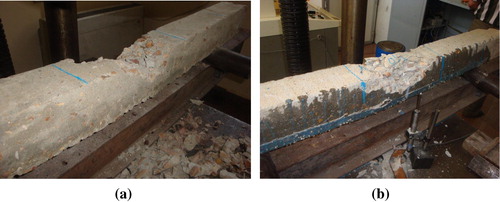
Table 4 Failure loads of unprotected RC beams.
FRP-strengthened RC beams thermally protected by types 1–5 and subjected to 600 °C
Ten RC beams, strengthened with GFRP laminates, were protected with different types of coating layers (types 1–5) and exposed to temperature 600 °C for 2 h. The temperature measured beneath the coating layer (on the surface of GFRP laminates) was recorded through the test and is plotted in . The results show that all five coating types are efficient in delaying heat transfer to the adhered GFRP system, with type 1 and 5 showing higher efficiency. shows two of these protected beams after exposure to temperature. After gradually cooling, the beams were tested in flexure till failure. The failure loads plotted in indicate that the residual strength was 61%, 68%, 72%, 73% and 74% of that of the control beam, for beams protected by protective layers of coating types 3, 4, 2, 1 and 5, respectively.
FRP-strengthened RC beams thermally protected by dual system and subjected to 600 °C
This group consists of 8 beams strengthened using GFRP, coated with dual system of coating layers (types 6–9) and exposed to a temperature of 600 °C for 2 h. The temperatures measured beneath the coating layer, are plotted in . After gradual cooling, the beams were tested in 4-point bending till failure, the failure loads are plotted in . The results show that all the four dual coating system types could protect the externally bonded GFRP system. The most efficient one was type 6 (ceramic fiber sheet followed by Perlite mortar) where, after 2 h of exposure to 600 °C, the temperature on the GFRP was only 130 °C. All protection layers succeeded to give a decrease of the residual strength of 1–5% only.
Conclusions
This research paper presents the efficiency of several coating layers used for thermal protection of FRP-strengthened RC beams. Based on the obtained results, the following main conclusions are drawn.
| 1. | Exposing unprotected RC beams to temperature of 200, 300, 400, 500 and 600 °C for 2 h, gradually cooling, then loading in bending till failure, recorded a decrease in the beam flexural capacity of 10%, 24%, 38%, 48% and 66%, respectively, compared to control beams kept at room temperature. | ||||
| 2. | Protecting RC beams by a 30 mm-thick layer of cement, Perlite, Vermiculite or Aswan clay mortar, or a layer of ceramic fiber blanket was demonstrated to give good thermal insulation and retain the residual flexural strength through 2-h exposure to 600 °C. Protection layers of cement mortar, Aswan clay, Vermiculite, Perlite and ceramic fiber blanket, showed residual flexural capacity equal to 61%, 68%, 72%, 73% and 74% that of the control beam, respectively. | ||||
| 3. | Using a double coating system (ceramic fiber followed by Perlite plaster, Vermiculite plaster, PC plaster or Aswan clay) with overall total thickness of 50 mm was demonstrated to give better protection, and maintain residual flexural capacity nearly equal to that of the control beams. | ||||
| 4. | All of the proposed commercially available and inexpensive protection systems for the tested FRP-strengthened beams proved to be efficient in reducing heat transfer and thus provide higher fire rating. It also succeeded to maintain 61–80% of the load carrying capacity of the beam after being exposed to elevated temperature of 600 °C for 2 h. | ||||
Conflict of interest
None declared.
Notes
Peer review under responsibility of Housing and Building National Research Center.
References
- ACI 440.2R-08Guide for the Design and Construction of Externally Bonded FRP Systems for Strengthening Concrete Structures2008American Concrete InstituteFarmington Hills, MI, USA
- ECP 208-2005. Egyptian Code of Practice for the Use of Fiber Reinforced Polymers in the Construction Field, Ministry of Housing and Urban Communities, Cairo, Egypt, 2005.
- O.AriozEffect of elevated temperatures on properties of concreteFire Saf. J.422007516522
- M.HusemThe effects of high temperature on compressive and flexural strengths of ordinary and high-performance concreteFire Saf. J.412006155163
- A.A.BashandyInfluence of elevated temperatures on the behavior of economical reactive powder concreteJ. Civ. Eng. Res.3320138997
- K.M.MorsyThe effect of fire protection materials and techniques on the structural behavior of RC beams strengthened with CFRPLProceedings of the 10th International Colloquium on Structural and Geotechnical Engineering2003Ain Shams UniversityCairo, Egypt April 22–24.
- L.A. Bisby, Fire behavior of fiber-reinforced polymer (FRP) reinforced or confined concrete (Ph.D. thesis), Queen’s University, Kingston, ON, Canada, 397 p., 2003.
- H. Blontrock, L. Taerwe, S. Matthys, Properties of fiber reinforced plastic at elevated temperature with regard to fire resistance of reinforced concrete members, in: Proceedings of the 4th International Symposium on Fiber Reinforced Polymer Reinforcement for Reinforced Concrete Structures, USA, 1999.
- R.BarnesJ.FidellPerformance in fire of small-scale CFRP strengthened concrete beamsJ. Compos. Constr.1062006503508
- M. Abd-Elghaffar, Effect of fire on reinforced concrete beams strengthened using modern fibrous composite materials, (M.Sc. thesis), Cairo University, Egypt, 2007.
- B.WilliamsV.KodurM.F.GreenL.A.BisbyFire endurance of fiber-reinforced-polymer strengthened concrete T-beamsACI Struct. J.105120086067
- A.AhmedV.KodurThe experimental behavior of FRP-strengthened RC beams subjected to design fire exposureEng. Struct.337201122012211
- M. Abdel Razik, A.M. Ragab, H.A. Hodhod, A.M. Rashed, Coating protection of loaded RC columns against elevated temperature, International Conference on Future Vision and Challenges for Urban Development, Cairo. Egypt, 20–22 December, 2004.
- A.E. Salama, G.M. Ghanem, S.F. Abd-Elnaby, A.A. El-Hefnawy, M. Abd-Elghaffar, Behavior of thermally protected RC beams strengthened with CFRP under dual effect of elevated temperature and loading, HBRC Journal, vol. 8, No. 1, April 2012.
- N.M.NofalG.A.HamdyEffect of fire protection materials on FRP strengthened concrete axial compression membersJ. Eng. Appl. Sci.526200511231141 Faculty of Engineering, Cairo University
- M.A. Abou-Atteya, Durability of fiber-reinforced polymer strengthening (M.Sc. thesis), Banha University, Egypt, 2011.
- ESS 4756-1/2006Cement: Composition and Conformance Criteria of Common Cements, Egyptian Standard Specification2009Ministry of IndustryCairo, Egypt
- ESS 1109/2008Aggregate, Egyptian Standard Specification2008Ministry of IndustryCairo, Egypt
- O-Basf Chemical Company, MBT® Protection and repair product data sheet: MBRACE® EG900: Unidirectional E-glass fiber for the MBrace® Composite Strengthening System, BASF Corporation Building Systems, MN, USA, 2012. <http://www.BuildingSystems.BASF.com>.
- ASTM C332-07Standard specification for lightweight aggregate for insulating concrete2007American Society for Testing and MaterialsPhiladelphia, USA
- The Egyptian Company for Manufacturing of Perlite and Vermiculite. Data Sheets provided in the company CD, 2010.
- ASTM E119-07Standard Methods for Fire Tests of Building Construction and Materials2007American Society for Testing and MaterialsWest Conshohocken, PA

